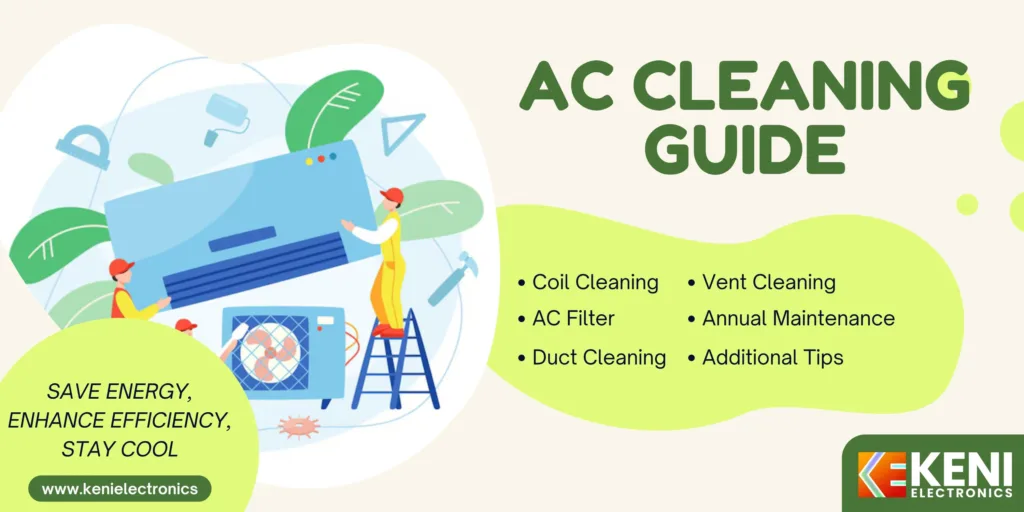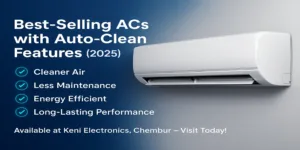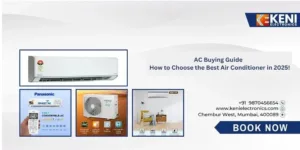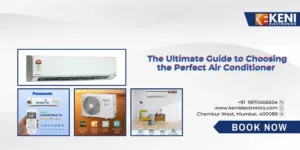Ultimate AC Cleaning Guide: Boost Efficiency, Save Energy, Stay Cool!

Table of Contents
Introducton:
Air conditioners are a vital part of keeping your home comfortable during the hot summer months. However, to ensure they perform efficiently and last longer, it’s essential to clean them regularly. Over time, dust, dirt, and grime can build up inside your air conditioning unit, causing it to work harder, consume more energy, and even emit unpleasant odors. Fortunately, cleaning your AC is not a difficult task if you know what to do.
In this comprehensive guide, we’ll cover everything you need to know about cleaning your AC—whether it’s a window AC, split AC, or central air system. From cleaning the filters and coils to sanitizing vents and ducts, we’ll walk you through the steps to keep your air conditioner running smoothly. Let’s dive in!
Why Is It Important to Clean Your AC?
Before jumping into the cleaning process, let’s understand why regular maintenance is so crucial. Cleaning your AC regularly offers several benefits:
- Improved Air Quality: Dust and allergens trapped in your AC can circulate in the air, affecting your health and comfort. Regular cleaning ensures your home stays fresher and healthier.
- Energy Efficiency: A dirty AC has to work harder to cool your home, which leads to higher energy consumption. Cleaning your unit can improve its efficiency, saving you money on your electricity bills.
- Prolonged Lifespan: Just like any other appliance, your AC will last longer if it’s maintained properly. Cleaning the filters, coils, and ducts helps prevent wear and tear.
- Better Cooling Performance: A clean AC is a more effective one. If your system is clogged or dirty, it won’t cool the air as efficiently.
Step-by-Step Guide to Cleaning Your AC
1. How to Clean Your AC Filter
The filter is the first line of defense against dust and allergens, and it’s one of the most important parts of your air conditioner to clean regularly.
Step-by-Step Process:
- Turn Off the AC: Before you start, always switch off the unit and unplug it for safety.
- Remove the Filter: Most AC units, both window and split, have a removable filter. Gently slide or lift the filter out from the unit.
- Clean the Filter: You can clean the filter by washing it with warm, soapy water. Use a mild detergent and a soft brush to remove any accumulated dirt. If the filter is heavily clogged, consider using a vacuum cleaner with a brush attachment to remove excess dust.
- Dry the Filter: Allow the filter to air-dry completely before reinserting it into the unit. Never insert a wet filter, as this can lead to mold and bacteria growth.
- Frequency: Clean the filter every 1-2 months, or more often if you have pets or live in a dusty environment.
2. AC Coil Cleaning: What Should You Know?
The coils in your air conditioner—the evaporator coil (inside) and the condenser coil (outside)—are responsible for absorbing and releasing heat. Over time, these coils can accumulate dirt, reducing their efficiency and leading to system malfunctions.
Step-by-Step Process:
- Turn Off the Unit: As always, disconnect the AC from the power supply before beginning any maintenance work.
- Clean the Coils: For the evaporator coil (located inside the unit), use a soft brush or vacuum cleaner to gently remove dirt and debris. For the condenser coil (outside), use a coil cleaner spray designed for AC units, or gently hose it down with water. Be careful not to damage the coils.
- Straighten the Fins: If the coils have bent fins, use a fin comb to straighten them. Bent fins can restrict airflow and reduce the cooling efficiency.
- Frequency: Coil cleaning is generally needed once a year, but if you live in a dusty or humid area, you may need to clean them more often.
3. AC Vent Cleaning: What Should You Know?
Your AC vents are the pathways through which cool air circulates throughout your home. Dirty vents can lead to clogged airflow, musty odors, and poor air quality.
Step-by-Step Process:
- Turn Off the AC: Always make sure your AC is turned off before cleaning the vents.
- Clean the Vents: Use a vacuum cleaner with a soft brush attachment to clean the vents. If the vents are very dirty, wipe them down with a damp cloth. For deeper cleaning, remove the vent covers and vacuum the inside.
- Frequency: Clean your AC vents every 3-6 months to ensure the air is flowing freely.
4. Air Duct Cleaning: What Should You Know?
Air ducts can accumulate dust, dirt, mold, and other contaminants that are then circulated through your home by the AC. Cleaning air ducts is essential for maintaining good indoor air quality and ensuring that your AC works efficiently.
Step-by-Step Process:
- Professional Cleaning: While you can clean some areas of your air ducts yourself (with a vacuum), it’s recommended to have them professionally cleaned every 3-5 years. Professionals use specialized equipment to remove dirt, mold, and debris from the entire duct system.
- Why It’s Important: Dirty ducts can not only lower the efficiency of your AC but can also negatively affect your health by spreading allergens or mold spores.
5. Schedule Annual Maintenance Service for Your AC
While basic cleaning tasks like filter and vent cleaning can be done at home, annual professional servicing is essential to keep your AC running at peak performance. During a service, a technician will check all components, clean the coils and condensate drain, inspect refrigerant levels, and ensure everything is working properly.
Why You Need Annual Maintenance:
- Expert Inspection: Technicians can spot small issues before they become major problems, helping you avoid costly repairs.
- Thorough Cleaning: Professionals have the tools and expertise to clean hard-to-reach parts like the evaporator and condenser coils, air ducts, and refrigerant lines.
- Optimal Performance: Regular servicing helps maintain energy efficiency and cooling performance, ensuring your AC runs smoothly through every season.
6. Additional Tips to Keep Your AC Clean and Efficient
- Cover Your AC in Off-Season: If you live in a region with cold winters, cover your window AC or outdoor unit to protect it from dust, dirt, and moisture. This will help maintain the unit’s efficiency.
- Check for Leaks: Ensure that the seals around the windows or doors are intact and that the AC is not leaking cool air. This will improve the cooling efficiency and reduce energy wastage.
- Use a Dehumidifier: In humid areas, using a dehumidifier alongside your AC can help reduce excess moisture in the air, preventing mold and mildew buildup inside the unit.
Conclusion: Keep Your AC Running Like New
Cleaning your air conditioner regularly is essential to maintain air quality, efficiency, and cooling performance. By following the steps outlined in this guide, you can ensure that your AC works optimally year-round. From cleaning filters and coils to sanitizing vents and scheduling professional maintenance, these tasks will help you extend the life of your unit, save on energy bills, and stay comfortable during the hottest months.
Remember, a well-maintained AC is a happy AC—and a happy AC means a cool, comfortable home!







Add comment